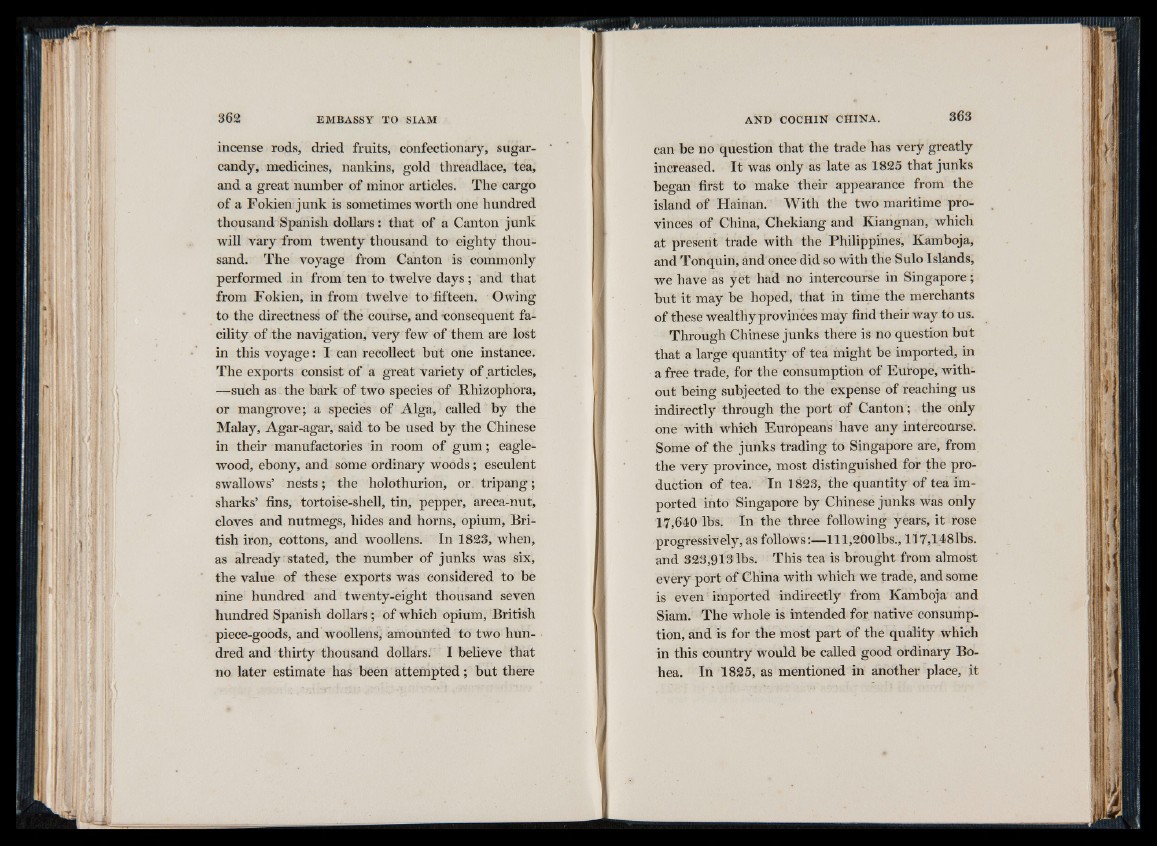
incense rods, dried fruits, confectionary, sugar-
candy, medicines, nankins, gold threadlace, tea,
and a great number of minor articles. The cargo
of a Fokien junk is sometimes worth one hundred
thousand Spanish dollars: that of a Canton junk
will vary from twenty thousand to eighty thousand.
The voyage from Canton is commonly
performed in from ten to twelve days; and that
from Fokien, in from twelve to fifteen. Owing
to the directness of the couise, and -consequent facility
of the navigation, very few of them are lost
in this voyage: I can recollect but one instance.
The exports consist of a great variety of articles,
—such as the bark of two species of llhizophora,
or mangrove; a species of Alga, called by the
Malay, Agar-agar, said to be used by the Chinese
in their manufactories in room of g um; eagle-
wood, ebony, and some ordinary woods; esculent
swallows’ nests; the holothurion, or. tripang;
sharks’ fins, tortoise-shell, tin, pepper, areca-nut,
cloves and nutmegs, hides and horns, opium, British
iron, cottons, and woollens. In 1823, when,
as already stated, the number of junks was six,
the value of these exports was considered to be
nine hundred and twenty-eight thousand seven
hundred Spanish dollars; of which opium, British
piece-goods, and woollens^ amounted to two hundred
and thirty thousand dollars.' I believe that
no later estimate has been attempted; but there
can be no question that the trade has very greatly
increased. I t was only as late as 1825 that junks
began first to make their appearance from the
island of Hainan. With the two maritime provinces
of China, Chekiang and Kiangnan, which
at present trade with the Philippines, Kamboja,
and Tonquin, and once did so with the Sulo Islands,
we have as yet had no intercourse in Singapore ;
but it may be hoped, that in time the merchants
of these wealthy provinces may find their way to us.
Through Chinese junks there is no question but
that a large quantity of tea might be imported, in
a free trade, for the consumption of Europe, without
being subjected to the expense of reaching us
indirectly through the port of Canton ; the only
one with which Europeans have any intercourse.
Some of the junks trading to Singapore are, from
the very province, most distinguished for the production
of tea. In 1823, the quantity of tea imported
into Singapore by Chinese junks was only
17,640 lbs. In the three following years, it rose
progressively, as follows:—111,200lbs., 117,148lbs.
and 323,913 lbs. This tea is brought from almost
every port of China with which we trade, and some
is even imported indirectly from Kamboja and
Siam. The whole is intended for native consumption,
and is for the most part of the quality which
in this country would be called good ordinary Bo-
hea. In 1825, as mentioned in another place, it